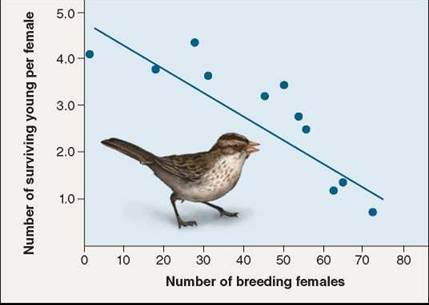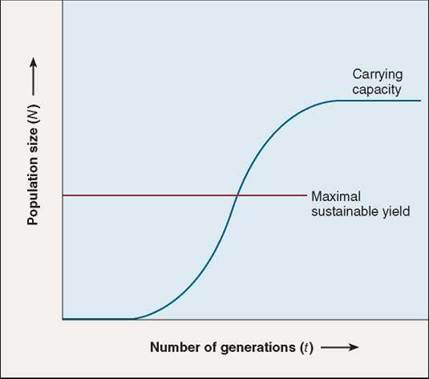THE LIVING WORLD
Unit Eight. The Living Environment
35. Populations and Communities
35.5. The Influence of Population Density
Many factors act to regulate the growth of populations in nature. Some of these factors act independently of the size of the population; others do not.
Density-Independent Effects
Effects that are independent of the size of a population and act to regulate its growth are called density-independent effects. A variety of factors may affect populations in a density- independent manner. Most of these are aspects of the external environment, such as weather (extremely cold winters, droughts, storms, floods) and physical disruptions (volcanic eruptions and fire). Individuals often will be affected by these activities regardless of the size of the population. Populations that occur in areas in which such events occur relatively frequently will display erratic population growth patterns, increasing rapidly when conditions are relatively good, but suffering extreme reductions whenever the environment turns hostile.
Density-Dependent Effects
Effects that are dependent on the size of the population and act to regulate its growth are called density-dependent effects. Among animals, these effects may be accompanied by hormonal changes that can alter behavior that will directly affect the ultimate size of the population. One striking example occurs in migratory locusts (which you encountered at the beginning of this chapter). When they become crowded, the locusts produce hormones that cause them to enter a migratory phase; the locusts take off as a swarm and fly long distances to new habitats. Density-dependent effects, in general, have an increasing effect as population size increases. As the population of song sparrows in figure 35.12 grows, the individuals in the population compete with increasing intensity for limited resources. Darwin proposed that these effects result in natural selection and improved adaptation as individuals compete for the limiting factors.

Figure 35.12. Density-dependent effects.
Reproductive success of the song sparrow (Melospiza melodia) decreases as population size increases.
Maximizing Population Productivity
In natural systems that are exploited by humans, such as fisheries, the aim is to maximize productivity by exploiting the population early in the rising portion of its sigmoid growth curve. At such times, populations and individuals are growing rapidly, and net productivity—in terms of the amount of material incorporated into the bodies of these organisms—is highest.
Commercial fisheries attempt to operate so that they are always harvesting populations in the steep, rapidly growing parts of the curve. The point of maximal sustainable yield (the red line in figure 35.13) lies partway up the sigmoid curve. Harvesting the population of an economically desirable species near this point will result in the best sustained yields. Overharvesting a population that is smaller than this critical size can destroy its productivity for many years or even drive it to extinction. This evidently happened in the Peruvian anchovy fishery after the populations had been depressed by the 1972 El Nino. It is often difficult to determine population levels of commercially valuable species, and without this information it is equally difficult to determine the yield most suitable for long-term, productive harvesting.

Figure 35.13. Maximal sustainable yield.
The goal of harvesting organisms for commercial purposes is to harvest just enough organisms to maximize current yields but also to sustain the population for future yields. Harvesting the organisms when the population is in the rapid growth phase of the sigmoidal curve, but not overharvesting, will result in sustained yields.
Key Learning Outcome 35.5. Density-independent effects are controlled by factors that operate regardless of population size; density-dependent effects are caused by factors that come into play particularly when the population size is larger.